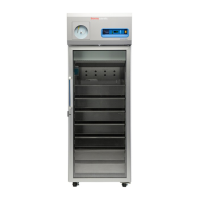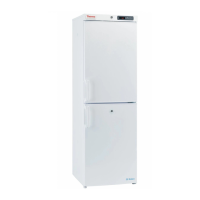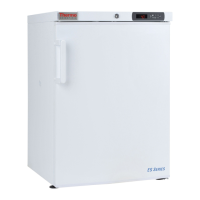Do you have a question about the Thermo Scientific TSX2305SA and is the answer not in the manual?
Recommends redundant temperature monitoring system for continuous performance.
Defines the product's purpose as cold storage, not a medical device.
Details technical specifications like voltage, current, weight, and dimensions.
Specifies ideal placement requirements for optimal performance and safety.
Instructions for ensuring the unit is properly leveled.
Information on electrical connections, grounding, and power source requirements.
Details standard shelves, capacity, and installation of shelf supports.
Information on drawer capacity, adjustment, removal, and reinstallation.
Details standard baskets, capacity, and adjustment.
Emphasizes the importance of securing the unit to prevent tipping.
Steps to install sensor probes into bottles for accurate temperature readings.
Notes on door function and the critical importance of the door seal.
How to connect factory-installed contacts for remote alarm systems.
Verifies removal of shipping materials and proper unit connection before startup.
Step-by-step instructions for powering on the refrigerator and initial checks.
Advice on how to load and unload the unit for optimal temperature uniformity.
Overview of the refrigerator's control panel layout and buttons.
Explains various display modes, logging, and mute functions.
Details how to access and adjust unit and alarm setpoints.
Instructions for accessing and modifying service parameters with cautions.
Information on factory default temperature and how to change it.
Description of the alarm system, activation, and audible warning functions.
Steps to set up and begin operating the chart recorder.
Procedure for replacing the chart paper in the recorder.
Explanation of the chart recorder's power sources and battery backup.
Guidance on calibrating and making adjustments to the chart recorder.
Instructions for cleaning the inside of the refrigerator.
Steps for cleaning the condenser filter.
Guidance on cleaning the condenser and safety precautions.
Explanation of the automatic defrost cycle.
How to inspect and maintain the door gasket for a proper seal.
Information on replacing the alarm system's backup battery.
Addresses issues with power and unit operation.
Covers causes and solutions for unstable temperature readings.
Explains what to do when the low battery indicator is active.
Troubleshooting steps for unexpected temperature increases.
Error code E01 indicates communication problems.
Error code E02 indicates a control probe failure.
Error code E03 indicates a defrost probe failure.
Error code E05 indicates an ambient probe failure.
Error code "Err" indicates an upper bottle probe failure.
Display shows "---" indicating lost communication.
States warranty limitations and disclaims implied warranties and liability.
Product compliance with EU WEEE Directive and disposal information.
Recommends redundant temperature monitoring system for continuous performance.
Defines the product's purpose as cold storage, not a medical device.
Details technical specifications like voltage, current, weight, and dimensions.
Specifies ideal placement requirements for optimal performance and safety.
Instructions for ensuring the unit is properly leveled.
Information on electrical connections, grounding, and power source requirements.
Details standard shelves, capacity, and installation of shelf supports.
Information on drawer capacity, adjustment, removal, and reinstallation.
Details standard baskets, capacity, and adjustment.
Emphasizes the importance of securing the unit to prevent tipping.
Steps to install sensor probes into bottles for accurate temperature readings.
Notes on door function and the critical importance of the door seal.
How to connect factory-installed contacts for remote alarm systems.
Verifies removal of shipping materials and proper unit connection before startup.
Step-by-step instructions for powering on the refrigerator and initial checks.
Advice on how to load and unload the unit for optimal temperature uniformity.
Overview of the refrigerator's control panel layout and buttons.
Explains various display modes, logging, and mute functions.
Details how to access and adjust unit and alarm setpoints.
Instructions for accessing and modifying service parameters with cautions.
Information on factory default temperature and how to change it.
Description of the alarm system, activation, and audible warning functions.
Steps to set up and begin operating the chart recorder.
Procedure for replacing the chart paper in the recorder.
Explanation of the chart recorder's power sources and battery backup.
Guidance on calibrating and making adjustments to the chart recorder.
Instructions for cleaning the inside of the refrigerator.
Steps for cleaning the condenser filter.
Guidance on cleaning the condenser and safety precautions.
Explanation of the automatic defrost cycle.
How to inspect and maintain the door gasket for a proper seal.
Information on replacing the alarm system's backup battery.
Addresses issues with power and unit operation.
Covers causes and solutions for unstable temperature readings.
Explains what to do when the low battery indicator is active.
Troubleshooting steps for unexpected temperature increases.
Error code E01 indicates communication problems.
Error code E02 indicates a control probe failure.
Error code E03 indicates a defrost probe failure.
Error code E05 indicates an ambient probe failure.
Error code "Err" indicates an upper bottle probe failure.
Display shows "---" indicating lost communication.
States warranty limitations and disclaims implied warranties and liability.
Product compliance with EU WEEE Directive and disposal information.
| Model | TSX2305SA |
|---|---|
| Temperature Range | +2°C to +8°C |
| Power Supply | 115V, 60Hz |
| Defrost | Automatic |
| Controller Type | Microprocessor |
| Interior Material | Stainless Steel |
| Refrigerant | R290 |
| Shelves | Adjustable |
| Door Type | Solid |











